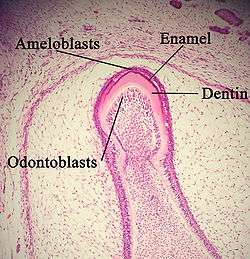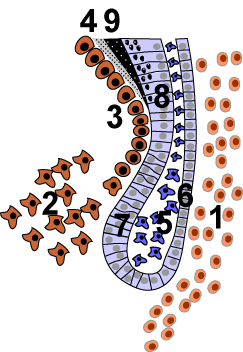Ameloblast
| Ameloblast | |
|---|---|
 A developing tooth with ameloblasts marked. | |
 The cervical loop area: (1) dental follicle cells, (2) dental mesenchyme, (3) Odontoblasts, (4) Dentin, (5) stellate reticulum, (6) outer enamel epithelium, (7)inner enamel epithelium, (8) ameloblasts, (9) enamel. | |
| Details | |
| Identifiers | |
| Latin | ameloblastus |
| Code | TE E05.04.1.1.2.3.20 |
Ameloblasts are cells present only during tooth development that deposit tooth enamel, which is the hard outermost layer of the tooth forming the surface of the crown.
Origin
Ameloblasts are derived from oral epithelium tissue of ectodermal origin. Their differentiation from preameloblasts (whose origin is from inner enamel epithelium) is a result of signaling from the ectomesenchymal cells of the dental papilla.
The ameloblasts will only become fully functional after the first layer of dentin (predentin) has been formed by odontoblasts. The cells are part of the reduced enamel epithelium after enamel maturation and then are subsequently lost during tooth eruption.[1]
Life cycle of ameloblasts [2]
The life cycle of ameloblasts consists of six stages :
- Morphogenic stage
- Organizing stage
- Formative (secretory) stage (Tomes' processes appear)
- Maturative stage
- Protective stage
- Desmolytic stage
The murine ALC cell line is of ameloblastic origin.[3]
Function
Ameloblasts are cells which secrete the enamel proteins enamelin and amelogenin which will later mineralize to form enamel, the hardest substance in the human body.[4] Ameloblasts control ionic and organic compositions of enamel. It is theorized that a circadian clock (24-hour) probably regulates enamel production on a daily cycle by the ameloblasts (similar to osteoblasts in production of bone tissue).[5][6] Ameloblasts adjust their secretory and resorptive activities to maintain favorable conditions for biomineralization.[7]
Structure
Each ameloblast is a columnar cell approximately 4 micrometers in diameter, 40 micrometers in length and is hexagonal in cross section. The secretory end of the ameloblast ends in a six-sided pyramid-like projection known as the Tomes' process. The angulation of the Tomes' process is significant in the orientation of enamel rods, the basic unit of tooth enamel.Distal terminal bars are junctional complexes that separate the Tomes' processes from ameloblast proper.
Pathophysiology
These cells are sensitive to their environment. One common example is illustrated by the neonatal line, a pronounced incremental line of Retzius found in the primary teeth and in the larger cusps of the permanent first molars, showing a disruption in enamel production when the person is born.[8] High fevers in childhood are also an example of bodily stressors causing interruptions in enamel production.
Another possible example of this sensitivity (stress response pathway activation) may be the development of dental fluorosis after childhood exposure (between the ages of 2 to 8 years old) to excess fluoride, an elemental agent used to increase enamel hardness and prevent dental caries.[9]
References
- ↑ Ten Cate's Oral Histology, Nanci, Elsevier, 2013, page 103
- ↑ Ten Cate's Oral Histology, Nanci, Elsevier, 2013, page 153
- ↑ Takahashi, Satomi; Kawashima, Nobuyuki; Sakamoto, Kei; Nakata, Akira; Kameda, Takashi; Sugiyama, Toshihiro; Katsube, Ken-Ichi; Suda, Hideaki (2007). "Differentiation of an ameloblast-lineage cell line (ALC) is induced by Sonic hedgehog signaling". Biochemical and Biophysical Research Communications. 353 (2): 405–11. doi:10.1016/j.bbrc.2006.12.053. PMID 17188245.
- ↑ Gallon V, Chen L, Yang X, Moradian-Oldak J. Localization and quantitative co-localization of enamelin with amelogenin. J Struct Biol. 2013 Apr
- ↑ Sehic A, Nirvani M, Risnes S. Incremental lines in mouse molar enamel. Arch Oral Biol. 2013
- ↑ Zheng L, Seon YJ, Circadian rhythms regulate amelogenesis. Bone. 2013
- ↑ Ten Cate's Oral Histology, Nanci, Elsevier, 2013, page 147
- ↑ Illustrated Dental Embryology, Histology, and Anatomy, Bath-Balogh and Fehrenbach, Elsevier, 2011, page 151
- ↑ Sierant, Megan L.; Bartlett, John D. (2012). "Stress Response Pathways in Ameloblasts: Implications for Amelogenesis and Dental Fluorosis". Cells. 1: 631–645. doi:10.3390/cells1030631. PMC 3671616
 . PMID 23745169.
. PMID 23745169.
External links
- Simmer, JP; Papagerakis, P; Smith, CE; Fisher, DC; Rountrey, AN; Zheng, L; Hu, JC (2010). "Regulation of dental enamel shape and hardness". J. Dent. Res. 89: 1024–38. doi:10.1177/0022034510375829. PMC 3086535
 . PMID 20675598.
. PMID 20675598.